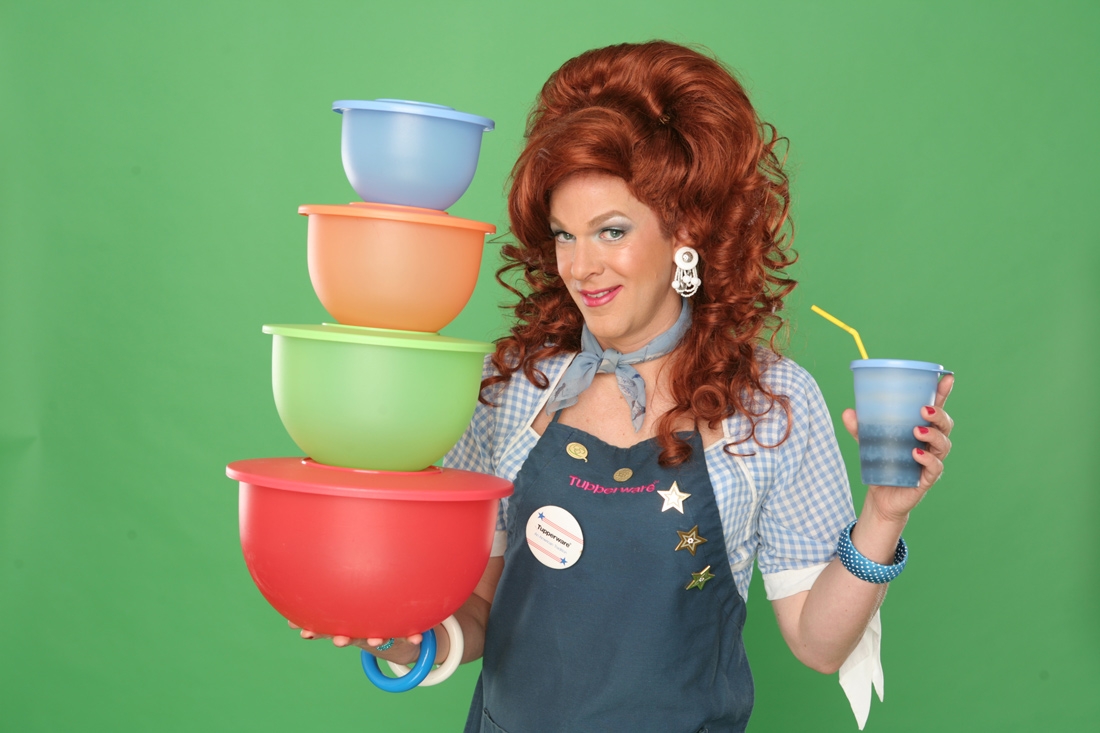Dixie Longate embodies everything brilliant about drag. She’s beautiful, buxom and bawdy; she throws shade at everyone in the room and makes them laugh so hard they nearly pee their pants; her entire show is a wildly satirical cultural critique of heteronormativity and capitalism — while simultaneously capitalizing on both; and yet, in the end, she’s really just a big ball of love who makes everybody feel good for having been in her company.
This is why Kris Andersson’s 2001 New York Fringe Festival show turned Off-Broadway and Drama Desk Award nominated hit has become a successful touring show. Directed by Patrick Richwood, Dixie’s Tupperware Party plays as easily to a small crowd of mostly housewives, retirees and gay men at Miller Auditorium in Kalamazoo as it likely did in an off-Broadway theater in Manhattan — without taming or otherwise sugarcoating the raucous material.
Dixie is Andersson’s creation, and his alter ego: America’s Favorite Tupperware lady, a darling little amazonian, red-headed, twangy fast-talking, gum-smacking, hard-drinking, ex-con from Mobile, Ala. with three kids she’d rather send back and three dead ex-husbands. Good riddance.
What she’s truly passionate about is throwing a good party, and everyone’s invited to her Tupperware party, which, by the way, is a real Tupperware party at which audience members can purchase “the fantastic Plastic crap” that Dixie, the fictional character, actually became a top seller of within a year of putting on the show.
“That’s right, hookers. I’m busy,” Dixie playfully tells the audience. “I’m so excited to be here, I could ride a mechanical bull with no panties on!”
She also fondly refers to women as “lesbians” whether they are or not, and shamelessly makes fun of them throughout the 100 minutes of making the sales pitch for various Tupperware products through her creative uses for them, most of which include uproarious sexual innuendo.
“I want you to think outside my box,” she says, with a double entendre that never gets old, of the Rectangular Cake Taker, number 1511 in the legitimate catalogue handed out with the show program, the base of which can be flipped over to transport up to 18 cupcakes, or, in Dixie’s pitch, 34 jello shots. “It’s like jello, but it makes you take your pants off,” she quips while sipping bourbon from a purple Tupperware sippy cup.
Later, she double fists it with another sippy cup full of pink wine she opened on stage with a Tupperware corkscrew, a product “for the car,” she said. “When it gets tighter, you screw harder,” she explained. “Even a lesbian knows that.”
Andersson’s timing is impeccable, as are his impressive improvisational skills. He has the audience eating out of his collapsible Tupperware bowls from start to finish. Lighting Design by Richard Winkler and Sound Design by Christopher K. Bond are executed without a hitch and help cultivate the false intimacy of an auditorium show that feels more like a cabaret. Andersson’s high octane energy, as well as schmoozing in the aisles before and after the show, coupled with bringing audience members on stage for games such as a hilarious “rimming race,” all draw people together.
This is ultimately what the show is about. Dixie brings the laughter down a notch with her own real talk about domestic violence and the value of knowing one’s own worth — if even through a plastic crystal-cut candy dish — as well as her admiration for Brownie Wise, the first woman to take the Tupperware bowls off the store shelves and into her friends’ and neighbors’ living rooms, proving women had minds for business and hearts for each other.
“Sixty-eight years later we’re all still at her party,” Dixie said. Though with Dixie as hostess, we’re undoubtedly having a lot more fun.





